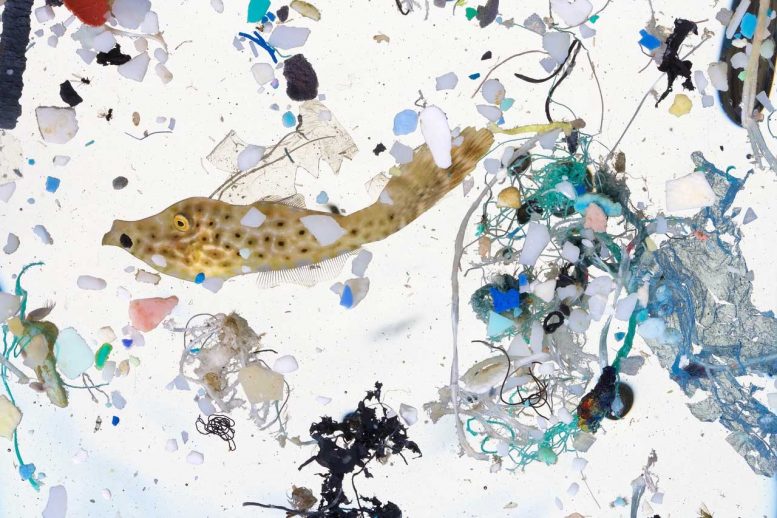
A scribbled filefish, about 50 days old and 2 inches long, surrounded by plastics. Credit: David Liitschwager
New research shows that many larval fish species from different ocean habitats are surrounded by and ingesting plastics in their preferred nursery habitat.
Many of the world’s marine fish spend their first days or weeks feeding and developing at the ocean surface. Larval fish are the next generation of adult fish that will supply protein and essential nutrients to people around the world. However, little is known about the ocean processes that affect the survival of larval fish. NOAA’s Pacific Islands Fisheries Science Center and an international team of scientists conducted one of the most ambitious studies to date to learn where larval fish spend their time and what they eat there.
The study was published yesterday (November 11, 2019) in the journal Proceedings of the National Academy of Sciences. The researchers combined field-based plankton tow surveys and advanced remote sensing techniques to identify larval fish nursery habitats in the coastal waters of Hawai‘i.
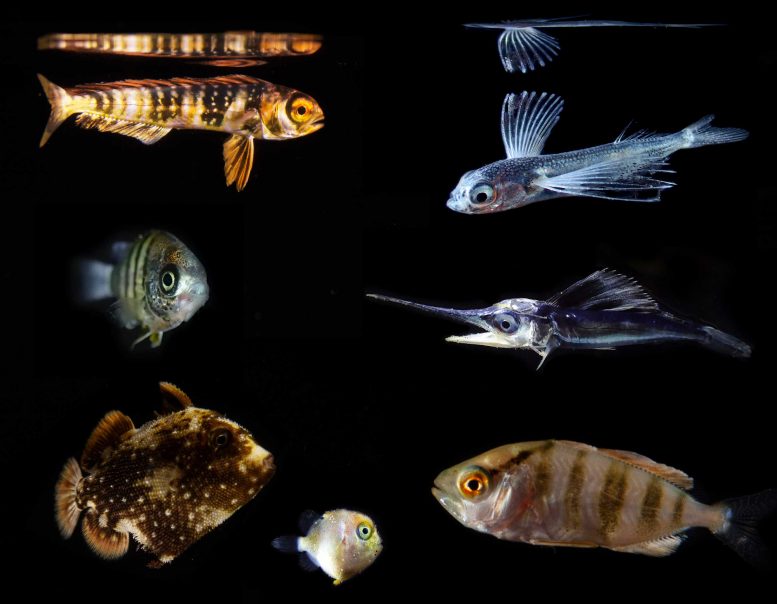
Numerous larval fish, often just weeks old, had plastics in their stomachs, including (top left, then clockwise) mahi-mahi, flying fish, spearfish, jacks, triggerfish (two sizes), and damsels. Photo: NOAA Fisheries/Jonathan Whitney. Credit: NOAA Fisheries/Jonathan Whitney
The team found that surface slicks contained far more larval fish than neighboring surface waters. Surface slicks are naturally occurring, ribbon-like, smooth water features at the ocean surface. They form when internal ocean waves converge near coastlines in marine ecosystems worldwide. The surface slicks also aggregate plankton, which is an important food resource for larval fish.
“We found that surface slicks contained larval fish from a wide range of ocean habitats, from shallow-water coral reefs to the open ocean and down into the deep sea—at no other point during their lives do these fish share an ocean habitat in this way,” said Dr. Jonathan Whitney, a marine ecologist for the Joint Institute for Marine and Atmospheric Research and co-lead of the study. “Slick nurseries also concentrate lots of planktonic prey, and thereby provide an oasis of food that is critical for larval fish development and survival.”
Larval fish in the surface slicks were larger, well-developed, and had increased swimming abilities. Larval fish that actively swim will better respond and orient to their environment. This suggests that tropical larval fish are actively seeking surface slicks to capitalize on concentrated prey.
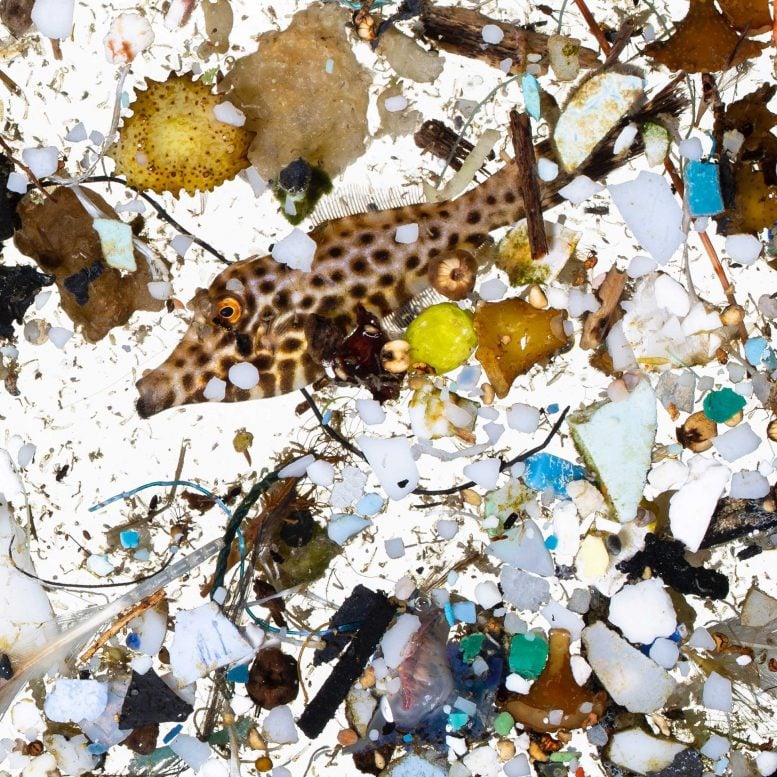
A scribbled filefish in a sea of plastics sampled from surface slicks off Hawai‘i Island. Credit: David Liittschwager
Unfortunately, the team also discovered that the same ocean processes that aggregated prey for larval fish also concentrated buoyant, passively floating plastics. “We were shocked to find that so many of our samples were dominated by plastics,” said Dr. Whitney.
Plastic densities in these surface slicks were, on average, eight times higher than the plastic densities recently found in the Great Pacific Garbage Patch. After towing the net 100 times, they found that plastics were 126 times more concentrated in surface slicks than in surface water just a couple hundred yards away. There were seven times more plastics than there were larval fish.
The majority of the plastics found in surface slicks were very small (less than 1 mm). Larval fish prefer their prey this size. After dissecting hundreds of larval fish, the researchers discovered that many fish species ingested plastic particles. “We found tiny plastic pieces in the stomachs of commercially targeted pelagic species, including swordfish and mahi-mahi, as well as in coral reef species like triggerfish,” said Dr. Whitney. Plastics were also found in flying fish, which apex predators such as tunas and most Hawaiian seabirds eat.
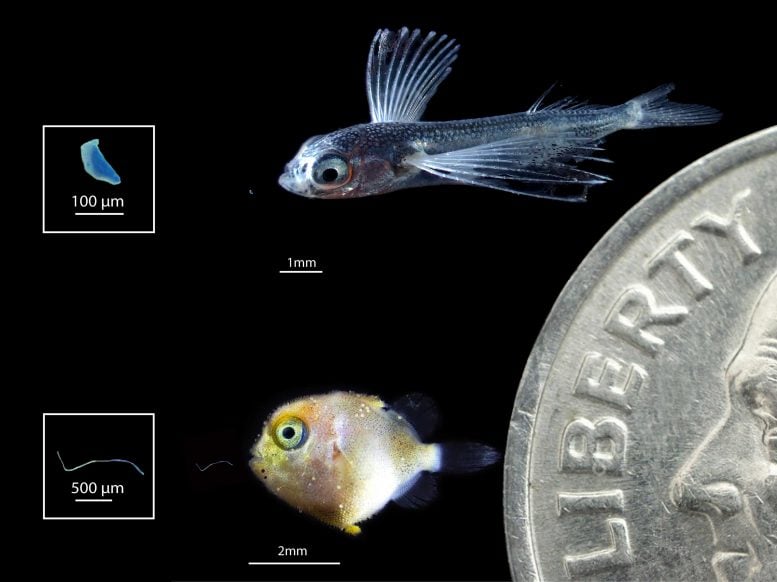
Larval flying fish (top) and triggerfish (bottom) with magnified plastics that fish ingested (left). Dime shown for scale. Credit: NOAA Fisheries/Jonathan Whitney
While recent evidence shows that adult fish ingest plastic, this is the first study to show that larval coral reef fish and pelagic species are also consuming plastic, as early as days after they are spawned.
“Larval fish are foundational for ecosystem function and represent the future of adult fish populations,” said Dr. Jamison Gove, a research oceanographer for NOAA and co-lead of the study. “The fact that larval fish are surrounded by and ingesting non-nutritious toxin-laden plastics, at their most vulnerable life-history stage, is cause for alarm.”
Researchers are unsure of how harmful plastic ingestion is to larval fish. In adult fish, plastics can cause gut blockage, malnutrition, and toxicant accumulation. Larval fish are highly sensitive to changes in their environment and food. Prey-size plastics could impact development and even reduce the survivorship of larval fish that ingest them.
The researchers measured the size and distribution of the surface slicks using satellites. Even when viewed from space, surface slicks are distinct from the rest of the ocean. The researchers found that surface slicks comprise less than 10 percent of ocean surface habitat but are estimated to contain about 42 percent of all surface-dwelling larval fish and nearly 92 percent of all floating plastics. “Surface slicks had never been mapped before, but we knew it would be vital to scaling up the field-based study. Our new method developed for this study can be applied anywhere in the world,” noted co-author Dr. Greg Asner of Arizona State University’s Center for Global Discovery and Conservation Science.
“Biodiversity and fisheries production are currently threatened by a variety of human-induced stressors such as climate change, habitat loss, and overfishing. Our research suggests we can likely now add plastic ingestion by larval fish to that list of threats,” said Dr. Gove.
Some scientists criticize the attention on plastic pollution. They say that it is distracting society from tackling more known and severe threats to global fisheries.
“We agree that curbing carbon emissions and finding more sustainable ways to fish must be a priority, but our findings suggest further investigation is needed to understand the effects of plastic ingestion by larval fish on individuals and populations,” said Dr. Gareth Williams, Associate Professor in Marine Biology at Bangor University (U.K.) and co-author of the study. “We as a society have the ability to make changes that would alleviate the stress on ecosystems imposed by our activities. We can and should start making those changes now, to limit stress to already severely threatened marine life.”
Reference: “Prey-size plastics are invading larval fish nurseries” by Jamison M. Gove, Jonathan L. Whitney, Margaret A. McManus, Joey Lecky, Felipe C. Carvalho, Jennifer M. Lynch, Jiwei Li, Philipp Neubauer, Katharine A. Smith, Jana E. Phipps, Donald R. Kobayashi, Karla B. Balagso, Emily A. Contreras, Mark E. Manuel, Mark A. Merrifield, Jeffrey J. Polovina, Gregory P. Asner, Jeffrey A. Maynard and Gareth J. Williams, 11 November 2019, Proceedings of the National Academy of Sciences.
DOI: 10.1073/pnas.1907496116

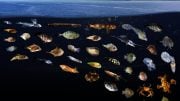
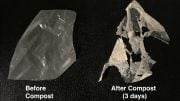
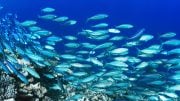
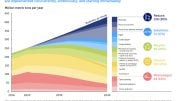
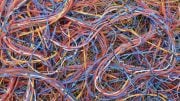


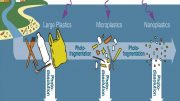
Can we just agree that the “human” race does not deserve to continue and quietly file into the disintegrators now please. There is no going back from this.